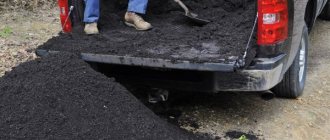This vegetable was once of a completely different type, unsightly, less tasty, and not everyone would dare to eat it. Now carrots are a wonderful and literally irreplaceable vegetable, which is used from feeding children to food for the elderly. And, it would seem, what could be simpler? I prepared the bed, sowed carrot seeds, even planted onions nearby so that there would be no trace of the onion fly, and the harvest would simply be nonexistent. What is the reason and what to do? In this article we will look at 12 possible reasons for poor carrot growth and tell you what to do in one case or another.
Growing carrots. © Terese
Dry, too wet or compact soil
Carrots will grow best in light and moderately moist soils. If it is dry, the root crop will not grow; on excessively damp soil there is also no chance; if the soil is dense, it can grow, but it will be weird and clumsy.
How to fix dense soil? A bucket of river sand per square meter (this is 12 or 13 kg), until the soil becomes loose and fluffy, then the carrots will be just very comfortable, and you will be surprised how ideal it will be.
Those who think that carrot seeds can be sown directly on the surface of the turf are also greatly mistaken. Contrary to the opinion that came from somewhere that carrots are practically a weed, they need prepared soil. Therefore, before sowing carrot seeds, be sure to dig the soil deeply with a shovel full, loosen it, and then I advise you to also walk with a rake so that the bed for sowing carrots is softer than grandma’s feather bed.
Rules for a great harvest
To avoid complaining that your carrots are not growing, follow these recommendations:
- Remove weeds regularly, especially during the active root growth stage.
- Keep the soil moist, but do not allow water to stagnate.
- When planning to hill, choose cloudy weather or a day after rain. At this time, the most famous pest - the carrot fly - is least active.
- Do not allow an earthen crust to form. If it is not possible to monitor the looseness of the soil, sprinkle the carrot seedlings with a layer of wood ash.
- Use mulch. Dry grass or compost will protect the soil from drying out, slow down the development of weeds and become a source of additional nutrition for plants.
- Don't forget to feed your root vegetables. Folk remedies are suitable: yeast, ash, iodine, bird droppings. All these feedings are good at the seedling stage. In the future, you can add store-bought fertilizers - superphosphate, ammonium nitrate, etc.
Growing good carrots is not very easy, but it is quite possible. The root vegetable loves attention. Take care of the beds in a timely manner so that at the end of the season the crop will please you with quality and volume.
om harvest.
Arrangement of beds with carrots in the shade
Continuing the topic of soil, root crops will grow well only on soils that are completely exposed to the rays of the sun; they may not tolerate even short-term shade and will slow down their development.
Ideally, a vegetable grower should arrange beds with carrots in such a way that each plant is illuminated by the sun and does not shade each other. Naturally, location near large crops, such as corn, is unacceptable or only permissible if these (tall) plants are located on the north side of the carrots, that is, they will not create any shade for it.
The right choice of fertilizers for carrots.
Many gardeners are interested in what they can feed their plants if they have weak tops.
- The easiest way to spray the plantings is with a urea solution.
This feeding is especially effective several months before harvesting for late varieties.
- Ingredients such as boric acid and magnesium sulfate are also suitable for foliar treatment of plants.
- Today, ready-made mixtures such as “Tsitovit”, “Ava” and other fertilizers containing everything necessary for vegetables are gaining popularity among summer residents.
Universal fertilizers also contain zinc, magnesium and copper; they increase plant immunity and make the harvest of root crops juicier and tastier.
It is useful to use not only minerals, but also folk remedies that have been proven for centuries, because people began growing carrots a very long time ago. Gardeners knew how to feed this crop many years ago.
Humus, compost, ash, herbal infusions, organic matter - all this has a positive effect on plants.
Yeast feeding.
There is nothing better than feeding carrots in July with regular baker's yeast. You can add:
- 1 small pack of product for a solution of chopped nettle and wood ash.
- Cultivated mushrooms also go well with sugar.
- Since this fertilizer is very concentrated, 1 liter of solution is poured with 10 liters of water.
Yeast fertilizer is effective and allows you to get a generous harvest, but you cannot apply it more than 3 times per season.
Loosening the soil
In general, how do you feel about the soil? Are you aware that the most crucial moment for carrots is the period when the seeds germinate and shoots appear? So during this period it is extremely bad if there is a soil crust on the surface of the soil.
Ideally, after each rain or watering, you need to destroy it as carefully as possible. If you have carrots at your dacha, then so that the soil crust does not inhibit its growth, it is necessary after each watering, before leaving, to cover it with a thin (a couple of millimeters) layer of wood ash (this is a good potassium fertilizer, and it also contains microelements).
Important ! Always try to water the soil or wait for rain and then loosen the soil, not the other way around.
Hilling carrots
Watering
When it comes to watering, a golden mean must be observed: do not allow the soil to dry out or overflow. First, the green mass gains strength, and only then does the fruit appear. That’s when the root crop needs plenty of moisture.
It is important to know! After the carrots ripen, watering is reduced to a minimum, avoiding cracking of the fruit.
Incorrectly selected seeds
By the way, few people know that length still matters. So, the shorter and smaller the carrot root, the faster it ripens and vice versa. Therefore, when choosing seeds, read what is written on the bag, and do not chase gigantism, it is of little use.
A lyrical digression for those who are not satisfied with the growth rate of carrots - read the packaging more carefully, early ripening varieties have a ripening period of 55-65 days. You can’t say that you sowed yesterday and have already harvested today. And such varieties are not stored at all - I was convinced from my own experience.
Carrot requirements
Carrots are quite a demanding crop, especially when it comes to soil. She likes to grow in fertile, light, loose, permeable and weed-free soil.
The best site for planting carrots will be the one where manure was applied 1-2 years ago, since carrots react very poorly to fresh manure. In this case, many ugly, branchy root vegetables with very poor taste grow.
Also, non-standard carrots can grow under the following conditions:
- if you apply fertilizers containing chlorine, the root crops will bend or branch;
- if you deoxidize the soil on the eve of planting, the carrots become multi-tailed;
- if there are any disturbances in the soil, for example, pebbles, organic residues, etc.;
- if there is excess moisture in the soil, the root crop becomes hairy or cracks, the tops grow excessively;
- if you apply and feed unnecessarily nitrogen fertilizers, the carrots begin to branch;
- if we thin out the seedlings incorrectly;
- if there is not enough moisture during carrot growth, the carrot, trying to take the moisture it lacks from the soil, produces lateral roots, which has a bad effect on its taste and appearance (the pulp becomes coarse, the root crop is short and “horned”).
Based on this, preparing the soil for planting carrots must be approached with all responsibility.
Firstly
, it is better to prepare it in the fall: dig it up thoroughly; if it is necessary to deoxidize the soil, then add lime or dolomite flour for digging; You can also add phosphorus and potassium fertilizers. In general, it is best to add all kinds of additives to the soil for carrots, taking into account the type of soil on your site.
If you have peaty soil, then it would be good to add river sand, humus and clay soil to it.
If the soil is clayey - river sand, peat, humus, and with fertile chernozem soil we add only sand in the spring.
Secondly
, in the spring, the area for carrots, prepared in the fall, must be loosened quite deeply, after adding complex mineral fertilizer; try to select all the pebbles so that nothing interferes with the growth of the plant.
Another important condition for carrot growth is good lighting of the crops. Shading has a very negative effect on plant growth, especially in the initial stages.
If our plantings are dense and there are a lot of weeds, then the carrots stretch out, the formation of root crops slows down and a lot of small root crops are formed (the so-called under-growing).
Carrots are a relatively cold-resistant and drought-resistant plant. Its seedlings can tolerate frosts down to minus 2°C, and mature plants can tolerate frosts down to minus 4°C.
But for those root crops that have survived frost, the shelf life is still reduced.
Carrot seeds germinate at temperatures above 3°C, and the optimal temperature for its growth is about 18-25°C. If the temperature rises above 25°C, plant growth slows down.
When choosing a site for planting carrots, it is also advisable to take into account the fact that the best predecessors for them are plants such as tomatoes, legumes, cabbage, potatoes, cucumbers, and green crops.
Incorrect crop rotation
Predecessor? Have you really forgotten? But, fortunately, with carrots everything is not so complicated and, when choosing a previous crop, you can only focus on a couple of main requirements.
The first, and I think this is the most basic requirement, is that in a garden bed where there were carrots, it is at least stupid to re-sow carrots; wait two years, or better yet three, and you will see for yourself that the result will be completely different.
Well, the second rule is that carrots grow best only after tomatoes, cucumbers, potatoes, cabbage, onions, garlic, greens, but it’s better not to plant after lettuce and parsley, everything is simple here - there may be common pests.
How to understand that a root crop is stunted?
It is quite simple to understand that carrots grow poorly. It is worth paying attention to the condition of its green part:
- If the green mass of the plant develops slowly, looks sluggish and lifeless, then this means that the plant is slowing down in growth and is experiencing a lack of soil moisture.
- It is worth paying attention to the color of the tops. It should be deep green. If the color is light green or yellow, and there is drying out, then the crop is probably lacking nutrients.
- Damage to the root collar of a crop indicates the appearance of pests, which also affects the appearance of the tops (read separately about what pests, as well as plant diseases, can affect carrot growth, appearance and yield).
Thickened crops
Did you pull the carrots at all? Do you know that the optimal row spacing when planting carrots should be 22-23 cm, and the width of the bed should not be more than one and a half meters? This one just fits a row of four carrots, and you don’t need more.
Thickened crops, by the way, are pulled out in the phase of a pair of true leaves, and after a while (usually two or three weeks) again, so that there is 4-6 cm of free area between each carrot. And before thinning, first water the bed, and then pull the desired bush up. If you don't water the garden bed, you may affect neighboring plants, and this will affect their poor growth in the future.
Carrot shoots before thinning. © gardenfrisk
Incorrect choice of planting scheme
The distance between the rows of carrots should be 20 cm, and the width of the entire bed should not be more than half a meter. That is, no more than 4 rows in the garden.
Be sure to thin out the carrots, otherwise they will interfere with each other. And nothing good will come of it.
The carrots are thinned out for the first time when they have 2 true leaves. It needs to be watered before the event. This way there is less chance of touching a neighboring plant when pulling out a sprout. A plant torn out of the ground is unlikely to take root. Therefore, this must be done carefully so as not to pull out too much.
Frequent planting is one of the reasons why carrots do not grow
The carrots are thinned out a second time after 2-3 weeks, leaving 4 cm between sprouts. But be careful, if young carrot roots are damaged, the carrots will grow horned and gnarled. Other reasons for the unmarketable appearance of carrots can be found in the article - Why carrots are clumsy.
Incorrect planting depth
This is what newbies do, for some reason they try to push it deeper, but why? The optimal depth for carrot seeds on dense clay soil may be only a centimeter, but if the soil is loose and sandy, then you can push it deeper - up to four or even five centimeters. Here, of course, it also depends on the moisture supply of the soil, otherwise you can plant it deeply, and then water it so superficially that the moisture will not even reach the seeds.
And a personal secret, if you see that the spring is dry, if there is a minimum of rain and the water dries up, falling immediately on the surface of the soil, and the soil, among other things, looks like a desert, then it is quite possible to sow the seeds to a depth of five centimeters, and if the soil dense and rains often, then plant the seeds almost at the very surface.
How to feed carrots to make them sweet
To grow sweet carrots, fertilizing is necessary. According to many gardeners, wood ash will add sweetness. The potassium contained in its composition affects the taste. Ash is added to the soil before digging, and it is also used to dust plants or sprinkle it between rows. Thus, they kill “two birds with one stone”: the ash will supply the plant with potassium and at the same time protect it from the carrot fly. Experienced gardeners also believe that such fertilizer improves the keeping quality of root crops.
In addition, proper watering gives juiciness and sweetness. Of course, the frequency of watering depends on weather conditions (abundance or lack of rain) and the structure of the soil. On sandy and sandy loam soils it is necessary to water every week and very generously. Fertile and oily soil is also watered every week, but little by little.
But there are different opinions about the frequency of watering carrots. I found this review in the comments to one article.
Carrots are one of those crops that do not require additional watering. As soon as the leaves close together between the rows (before this point, you should water if it is very dry). Its root tends downward (the root system is taprooted) - this is how nature intended it - there is always water in the lower layers of the soil, despite the fact that it may be dry outside. By watering carrots, we disrupt the natural growth program - it makes no sense for it to strive down when there is water closer to the surface - this is how freaks are born. And I simply compensate for the lack of moisture during the dry period by having mulch between the rows of carrots.
I don’t know how you will feel about this opinion, although there is some truth here too. But I water my plot exactly as I told you. And I very rarely grow ugly carrots.
Hilling carrots
Have you forgotten about hilling? It seems like a simple operation, but for some reason few people do it. The thing is that during the growth period, a small, but still part of the carrot root, located on top, seems to stick out from the soil, it becomes bare, becomes not the usual carrot color, but a less pleasant one - green, and begins to accumulate with might and main, even if not very dangerous, but still a poison, called solanine. At the same time, the growth of carrots stops and freezes.
Therefore, you need to monitor the plantation and hill it up on time, which is especially effective after watering, rain, or on cloudy days, when the carrot fly life is minimal or non-existent.
Substances necessary for carrot growth.
Every summer resident who experiences failures must figure out why this or that vegetable grows poorly in the garden.
Orange carrots require many nutritional components during different periods of development, so a variety of fertilizers are chosen for the crop.
The plant needs the following minerals:
- nitrogen;
- potassium;
- phosphorus;
- boron and manganese.
If there is not enough nitrogen.
Carrots often do not grow due to a lack of nitrogen, because this component helps to increase the green mass of the plant.
Its deficiency is indicated by such signs as small yellowish leaves and small root size.
Potassium deficiency.
But potassium is responsible for photosynthesis; it makes the vegetable resistant to diseases and unfavorable environmental conditions.
Low bushes with brownish tops are a signal of a lack of an important microelement; the harvest will also be weak.
Lack of phosphorus.
Ground carrots and beets grow poorly in soil poor in phosphorus. The fact that the plants are starving is indicated by curling leaves and bright stripes on them, and the grown fruits become tasteless.
Boron and manganese help increase the sugar content of root crops, which is why it is necessary to feed the crop with these substances in a timely manner.
Well, about watering
Watering carrots is a complicated thing, and this is where many people begin to panic, asking why the root crops are not growing. In fact, carrots love the golden mean: abundance, but not excess moisture.
Carrots also have their own biological subtleties, which a real gardener should know about, for example, the growth of root crops actively begins after the end of leaf growth, and there is no need to pull the tops out of the soil and shout “where are the root crops?!”
Typically, the growth of root crops occurs in the last quarter of the growth of above-ground leaf mass. It follows that during the period of active growth, carrots need maximum moisture, but if you moisten the soil when the root crops finish growing, then you can slow down their development or lead to cracking.
A bed of carrots next to a bed of onions. © Tina Martino
Of course, we must not forget about the norms for watering carrots so that the root crop does not stop its development. So, for example, in hot weather, when moisture evaporates, you can water carrots three times a week in the evening, spending only four liters of water per square meter on young plants. But already in the middle of the carrot growing season, you can water once a week, pouring a bucket of water per square meter, and reduce it again towards the end of the growing season, as we mentioned earlier.
Rules for caring for carrots
To ensure that the vegetable pleases you with its growth, size and taste, adhere to the following care rules:
- Carrots are sown in the same place after the previous harvest only 2-3 years later. The vegetable grows well after tomatoes, cucumbers, cabbage, onions, and garlic.
- Before planting seeds, consider the location of the beds. During the growth process, each individual plant should not darken each other. They need full sunlight. For this reason, large crops are planted only on the north side of the carrots.
- It is important to create a favorable microclimate if the soil is not ideal in terms of indicators. 12-13 kg of sand per 1 m² is added to the soil, which will make it loose. Increased acidity is neutralized in the fall. To do this, add 1 tbsp. dolomite flour per 1 m² of land until the pH rises to 6-7. The beds are dug to the depth of a spade, making a “featherbed” for the capricious vegetable.
- Be sure to thin out the beds. The first thinning is carried out when there are 2 true leaves. After a couple of weeks, repeat the process so that there is at least 4-6 cm between each carrot. Before pulling, water the soil to soften it and not injure the vegetables.
- Loosen the soil after each watering and rain to prevent crust formation.
- Hilling is carried out at the stage when the vegetable has already appeared above the ground. It is effective after watering and on cloudy days, when there is no pest - the carrot fly.
- In hot weather, water 3-4 times a week in the evening - 4 liters of water per 1 m². In the middle of the growing season - 1 time per week with the same amount. During the period of active growth, when 3/4 of the tops have grown, stick to scanty watering, do not overwater.
- If the thermometer readings exceed +24°C, then periodically cool the vegetables by gravity watering from a hose in the evening. The water will saturate the ground a couple of centimeters, cool the soil and reduce the temperature above it.
- Don't forget to remove weeds from the garden bed.
Proper feeding
Carrots may not grow for the simple reason that you are feeding them incorrectly. You don’t need to do a lot of fertilizing, otherwise there will be angry reviews about the amount of nitrates and about the fact that there is also a lot of useful stuff in the air. On my site I carried out only three feedings and that was enough.
Both I and many gardeners did the first fertilizing after the emergence of seedlings - about three weeks later. To do this, we used liquid fertilizer - usually a tablespoon of nitrophoska per bucket of water. They fed the carrots again after 15-18 days, using two teaspoons per bucket of water, also in dissolved form.
Carrots respond very well to the application of potassium sulfate solution (literally 6-7 g per bucket of water at the consumption rate per square meter). It turns out that this is the third feeding, it has a positive effect on the growth of root crops and on their taste (they will be sweeter).
Have you decided to fertilize the soil with manure? Okay, then apply it in the spring at a rate of 5-6 kg per square meter of soil. During the season before planting carrots, let the manure decompose, dissolve, and transform into a form accessible to plants, then in the fall add 500 g of wood ash per square meter and you can safely plant carrots. The result will be wonderful.
Well, we tried to answer all the questions about why carrots don’t grow and what to do about it. If you have questions, ask them in the comments. If you have your own secrets for getting a good carrot harvest, we will also be happy to hear about them.
The main reasons why carrots grow poorly
Soil too acidic
The disadvantage of acidic soil is that in it the nutrients are converted into a form that is difficult to absorb, and the plant does not receive them, even after applying fertilizers (How to determine the acidity of the soil). To solve this problem, the soil must be deoxidized, but this process is not quick and is usually carried out in the fall.
An already planted ridge can be watered with baking soda, diluting 2 tablespoons in 10 liters of water and repeating it at least once a month. By the way, soda is often used as a fertilizer and protection against pests, so such watering will be useful for normal soil several times a season. In fact, for complete deoxidation the concentration should be much higher, but then the carrots will also die, so it’s better to leave it until the fall.
Pour in the infusion of ash, in the proportion of a glass per 10 liters. Ash is also a fertilizer, but as a deoxidizing agent it acts more slowly than soda.
Lack of nutrients in the soil
If acidity is within normal limits, it means there is not enough nutrients. It is necessary to apply industrially produced fertilizers or those prepared with folk remedies.
How to feed carrots if they grow poorly:
- In the first half of summer. If the tops are small and pale, then there is a lack of nitrogen and phosphorus. To replenish them, carrots can be watered with fertilizer (Urea, Superphosphate, Nitroammophosphate , Nitrophoska) or an infusion of grass (how to prepare a herbal infusion) or manure (how to prepare mullein). This will help the plant grow strong tops, which will generate everything necessary for the growth of a large root crop.
- In the second half of summer. For the development of large root crops, phosphorus-potassium fertilizers with microelements, purchased or homemade, are needed. Ash infusion, Boric acid, Nitrophoska, Potassium nitrate, Potassium sulfate are suitable. For sweetness, root vegetables are sprinkled with salt or soda at the rate of 1-2 tablespoons per bucket.
Excess of nitrogen fertilizers in the second half of summer
Plants need nitrogen to grow green mass. From July, the tops reach their maximum and active growth of the root crop begins. But with the active application of nitrogen, the plant continues to grow new leaves and “forgets” to grow the root crop.
The soil is too heavy and dense
Carrots love light and loose soil. And if the leaves can grow successfully on dense soil, then the root crop will definitely not grow large. Ideally, the soil should be such that it can be turned by hand; if it needs to be dug up again to loosen it, and in the heat it becomes hard as stone, then what kind of harvest can we talk about?
Too dense clay soil must be mixed with sand, peat, ash, rotted sawdust to make it looser, lighter and more structured. In such a bed, carrots will grow better, and it will be easier for you to care for them.
If the carrots are already planted on a ridge with heavy soil, it must be loosened to a great depth, but very carefully so as not to damage the seedlings or plant roots. You can add baking powder after thinning in the phase of finger-thick root crops, when they leave a formed hole. Then the remaining plants will still have time to gain the necessary mass before the end of the season.
Thickened planting
Plants planted too close to each other lack all the components necessary for growth. In this case, the expectation that the more you plant, the more you will harvest, will not be justified.
- Plant leaves shade each other, and carrots cannot tolerate the slightest shade.
- Plants do not have enough moisture and nutrients, they are forced to compete with each other, some do not get enough, but in the end they all suffer and grow poorly.
- Growing root crops rest against each other and grow in the direction where it is freer, acquiring a bizarre shape.
To prevent this from happening, you must either sow carrots rarely or thin them out in a timely manner. Weeding rows of carrots should also not be neglected, and do this while the weeds are low and soft. Before weeding, water the bed well and wait until the water goes away so that there is no dirt. Annual weeds can simply be cut off so as not to damage the young carrot shoots.
Irrational watering
Carrots like it to be moist, but not soggy. The root crop grows 20-30 centimeters deep, so the soil must be soaked to this depth. When watering shallowly in hot weather, the soil in the depths remains dry and can become too hard. It is in such hard, dense dry soil that you get gnarled, horned, short and small carrots. Therefore, in hot weather it is necessary to water 2 times a week in the evening, pouring 1-2 watering cans per square meter of bed. It is also a good idea to mulch to retain moisture in the soil. And it’s better to do this before the soil dries out in the spring, in order to retain moisture both at depth and on the surface.
Carrot sowing dates
There are several dates for sowing carrot seeds and they depend on when and for what purposes we want to get the crop.
So, for example, to get an early harvest, carrots should be sown from mid-April to early May ( early spring sowing
). Carrots sown during these periods can be harvested in bunches from the end of June to the end of July, and from August we already receive a real root crop for summer consumption.
The next sowing period is from mid-May to early June ( summer sowing
). This is the main time for sowing carrots, which we will store for winter storage.
If we want to get young carrots in the fall, then we can sow short-fruited varieties in mid-July.
And winter sowing
seeds (from October 20 to November 15) can provide us with an even earlier harvest. But not every site is suitable for these purposes. For pre-winter sowing, we need to choose a place on our summer cottage where the snow melts earlier in the spring and the soil should be light, sandy loam, so that the crops do not float in the spring.
When sowing seeds before winter, they are only disinfected and then dried. In the spring they will gain moisture, swell and germinate naturally. It is not recommended to germinate the seeds, as the sprouts will freeze. Using these sowing dates, we will be able to have fresh carrots from summer to spring next year.
In addition, when sowing late carrots before the 20th of June, plant development does not coincide with the greatest activity of the carrot fly (in May), which makes it possible to grow higher-quality root crops.
How to store carrots
We store carrots in the basement (cellar) in wooden or plastic boxes. We put it in boxes in layers, sprinkle it with wet sand and try to arrange the root crops so that they do not touch each other.
It is also good to use moss instead of sand.
I would like to recommend another way to store carrots - “glazing” with clay. This is done like this: dilute the clay with water to the consistency of thick sour cream, dip the root vegetables in this “glaze” and place them on a wire rack so that the excess liquid dries off and the coating dries.
In such a shell, our carrots almost do not lose moisture and remain fresh until spring. But of course, the storage temperature should be about 00C and the storage should be dry.
If for some reason the previous methods of storing carrots are not suitable for you, then you can also sprinkle the root vegetables thickly with crushed chalk, thereby reducing the likelihood of putrefactive processes.
And if you additionally sprinkle the root vegetables with onion peels, they will be stored even better.
In this article, dear friends, I touched only on the issue of growing carrots , but I plan to talk about its varieties, all their diversity and the diseases and pests that plague carrots in the following articles.
See you soon, dear friends!











